ROADSIDE REVEGETATION
An Integrated Approach to Establishing Native Plants and Pollinator Habitat
3.13 Selecting Plant Species for Propagation
Selecting plant species to propagate and install on a project requires an understanding of the revegetation objectives (Section 3.2), identifying the limitations of the site to support the species being considered (Section 3.8), identifying the factors that affect pollinator (Section 3.9), and determining if the plant species integrate into the vegetation management strategy (Section 3.11). This section covers how to use the comprehensive species list and seed zones and transfer guidelines to develop a potential plant species list.
3.13.1 Developing a Potential Plant Species List
From the comprehensive species spreadsheet developed in Section 3.6.1, each species is evaluated for its potential to be used on the project. This is accomplished by sorting the spreadsheet using some or all of the following criteria:
- Nativity—If the revegetation objectives call for using native plants, then species on the comprehensive species list are first sorted by whether it is native or not.
- Pollinator-friendly—Based on the pollinator habitat assessment (Section 3.6.3, see Habitat Assessment), a list of pollinator plant species to enhance site quality for pollinators can be developed from the ERA tool and the reference site plant species inventory.
- Workhorse species—The next sort is by workhorse species. Workhorse species is a term used to describe locally adapted native plants that: (1) have broad ecological amplitude, (2) high abundance, and (3) are relatively easy to propagate. A list of workhorse species for ecoregions (Level III) can be obtained using the ERA tool. Because these lists are still in development, some species may need to be evaluated for potential as a workhorse species based on the project objectives and needs.
To determine if a species (not listed as a workhorse in ERA) is a potential workhorse species, sort the comprehensive species list by amplitude and abundance columns. Those species that have high amplitude and abundance are good candidates for workhorse species status. From these species, evaluate how easy they are to propagate. This includes the availability of the starter plant materials, how easy the species is to propagate in the nursery or seed production fields, how well the seeds store, the survival of the plant materials once they are installed on the project, and expense. - Availability of starter plant materials—Seeds, plants, and cuttings often have to be collected in the wild and supplied to the nursery or seed producer for plant production, seed increase, or stooling beds. Species that are difficult to obtain or collect are not good candidates for workhorse species status (Section 5.3.1 through Section 5.3.3).
- Nursery and seed production—Species that are difficult to propagate in the nursery, stooling beds, or seed production fields do not make good workhorse species (Section 5.3.4 through Section 5.3.6). Because new techniques in propagating native species is constantly improving, talking to nursery managers or seed growers, in addition to referring to documented plant production protocols available on the internet, is important in maintaining a current workhorse species list.
- Longevity—Seeds that have a poor shelf life under seed standard storage practices (seed germination that drops significantly after one year in storage) are often not good candidates (Section 5.3.4).
- Field establishment—The ease that a plant material will establish on a project site will determine if a species is a workhorse species (Section 5.3.3 and Section 5.5). Some species do not perform well because breaking seed dormancy and obtaining good germination may be difficult. Other species, planted as seedlings, experience unusually high transplant shock that significantly reduces plant survival.
- Expense—The total costs for establishing native plants on the project site is the easiest measure of whether a species is a good candidate for workhorse species status.
- Working groups—A working group is a mix of workhorse species developed for a specific ecological function or management objective. One of the best ways to develop working groups is to sort the comprehensive species list by ecological setting and succession. This will assemble species into groups that naturally occur together. From these groups, working groups are developed based on project objectives, such as pollinator habitat enhancement, weed control, visual enhancement, conservation management, and erosion control (Figure 3-93). The development of these working groups is often the basis for a project's seed mixes and planting mixes for each revegetation unit.
- Specialist species—Species that are important for achieving project objectives yet do not meet the workhorse species criteria for seed propagation are called specialist species (Figure 3-94). These species may still be propagated; however, because there may be very little information about seed propagation, they may take more time and higher costs to develop. Projects that contain special microclimates or soils may require a unique mix of specialist species (e.g., a wetland working group), while other projects may require a specific species to meet a project objective (e.g., milkweed as host plant for monarch butterfly). If only a small quantity of specialist species is needed, then methods other than seed propagation should be considered. These include collecting plant materials in the wild or growing seedlings in the nursery.
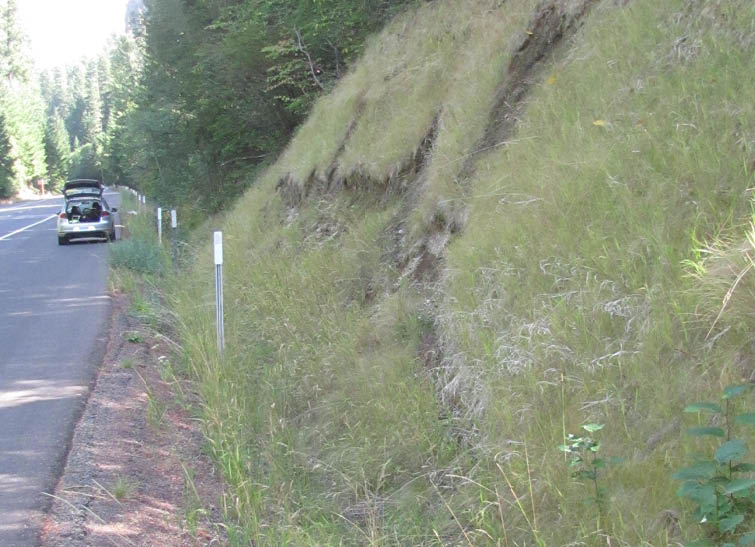
Figure 3-93 | Steep roadcuts require an erosion control working group
Steep roadcuts on the North Umpqua Highway in Oregon required an erosion control working group that hold the slopes together and keep them from sloughing and eroding into road ditches. An erosion control working group composed of Roemer's fescue (Festuca roemerii), blue wildrye (Elymus glaucus), and California brome (Bromus carinatus) was applied with high rates of hydromulch and tackifier to the cut slopes. One year after application, cut slopes had a high cover of these native grass species that significantly reduced sloughing and erosion.
Photo credit: David Steinfeld
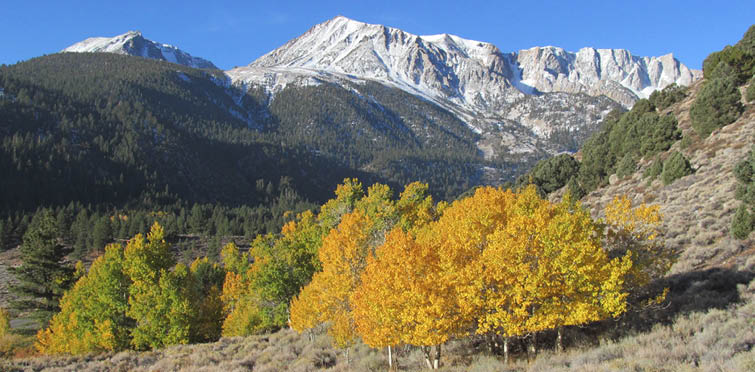
Figure 3-94 | Example of a specialist species
Aspen does not meet "workhorse" criteria because it is challenging to propagate (starter material is difficult to obtain and plants require special protection from browsing after outplanting). However, aspen is very important for ecological reasons, and therefore can be propagated as a specialist species for specific projects.
Photo credits: Chris Jensen USFS
Once the spreadsheet is complete, the species and stocktypes to propagate can be selected.
Table 3-14 | Selecting species to propagate
The comprehensive species list developed in Table 3-6 can be used to determine the species that are most appropriate to use on the project. In this example, non-native species were removed from the list, leaving only native species. Then potential workhorse species were determined by their amplitude, abundance, and ease of propagation. A species such as Achillea millefolium, for instance, is considered a workhorse species because it fits all criteria—high abundance, high amplitude, and easy to propagate. Whether this species is used for this project depends on whether it is a member of a particular working group that meets a specific project objective. Because Achillea millefolium fits into the "visuals" working group, which is an important road objective, this species is selected for propagation. Agastache urticifolia is also showy and has a high amplitude and abundance. However, very little is known about the propagation of this species. While this species has the potential of being a workhorse species, it will be grown as a trial in small quantities. Allium fibrillum and Allium macrum are specialist species that occur together in a unique meadow habitat. Because this road project provides an opportunity to enhance meadow habitat, these two species are placed in a "conservation" working group. They are considered specialists because they have low abundance, low amplitude, and little is known about their propagation, yet they are an important component of the working group. These species will be selected for use on the project; however, because little is known about seed propagation, seeds will be sent to a nursery for plant or bulb propagation.
Scientific name |
Common name |
Amplitude |
Abundance |
Succession |
Ecological setting |
Stocktype |
Propagation |
Workhorse species |
Working group |
Specialist |
Propagate |
Achillea millefolium |
common yarrow |
High |
High |
Early |
All |
Seeds |
Easy |
Yes |
Visuals |
Yes |
|
Agastache urticifolia |
horsemint |
High |
High |
Early |
All |
Seeds |
Unknown |
No |
Visuals |
Trials |
|
Agoseris aurantiaca |
orange agoseris |
High |
Mod |
Early |
All |
Seeds |
Unknown |
No |
|||
Agoseris glauca |
pale agoseris |
High |
Mod |
Early |
All |
Seeds |
Unknown |
No |
|||
Agoseris grandiflora |
bigflower agoseris |
High |
Mod |
Early |
All |
Seeds |
Unknown |
No |
|||
Abies grandis |
grand fir |
High |
High |
Late |
All |
Plants |
Easy |
Yes |
Yes |
||
Abies lasiocarpa |
subalpine fir |
High |
Mod |
Late |
Cool |
Plants |
Difficult |
No |
|||
Allium acuminatum |
tapertip onion |
Low |
Low |
Early |
Wet |
Bulbs |
Difficult |
No |
|||
Allium fibriatum |
fringed onion |
Low |
Low |
Early |
Warm/Dry |
Bulbs |
Difficult |
No |
Conservation |
Yes |
Yes |
Allium macrum |
rock onion |
Low |
Low |
Early |
Wet |
Bulbs |
Difficult |
No |
Conservation |
Yes |
Yes |
Allium madidum |
swamp onion |
Low |
Mod |
Early |
Wet |
Bulbs |
Difficult |
No |
3.13.2 Ensure Local Adaptation and Maintain Genetic Diversity
Seed Zones and Transfer Guidelines
It is important to know the original collection source and genetic background of target plant materials to ensure better long-term adaptation to local conditions and protect plant-pollinator relationships and the genetic resources of local plant communities. Seed transfer guidelines (how far plant material can be transferred from point of origin to the project with minimal risk of maladaptation) were initially developed for commercially important forest tree species. This was the outcome of years of research that revealed that failures in tree planting establishment were sometimes the result of moving seeds too far from their source of origin. More recently, research has been completed or is under way to develop seed zones and transfer guidelines for grasses, forbs, and shrub species commonly used in revegetation activities, particularly in the western U.S. (e.g., Table 1 in Bower and others 2014; St. Clair and others 2013; Johnson and others 2013; Horning 2010).
Seed sources that originate within the specific seed zone where a planting site is located are likely to be well adapted, with improved survival, reproductive success, and resiliency in harsh sites and changing climate conditions. Genetic research indicates there is no fixed number determining the geographic distance that plants might be successfully moved (e.g., within a 50-mile radius). Rather, "local" is best defined in terms of the environment (local climate and soils) rather than absolute distance. Many factors contribute to the environmental conditions to which a plant species must adapt, including rainfall, aridity, maximum and minimum temperatures, aspect, soil drainage, and pH. The scale of adaptation also varies greatly among species. Some species (genetic generalists) can tolerate broader movement across environmental gradients than others (genetic specialists) and still be well adapted to local conditions and regions (Rehfeldt 1994; Johnson and others 2010). Thus, plant movement guidelines derived from empirical genetic studies are specific to the individual species and geographic area where the research was conducted.
In addition to improving the success of revegetation projects, seed zones can create efficiencies and economies of scale in commercial markets and seed banking programs and partnerships (Erickson 2008). This will reduce the cost of native plant material production and use, as well as increase the availability of genetically appropriate plant materials. Despite the numerous benefits, genetic guidelines for plant material movement are lacking for many native grass, forb, and shrub species used in roadside revegetation and pollinator habitat enhancement activities. In these cases, generalized provisional seed zones (Figure 3-95) (Bower and others 2014) may be useful in guiding seed movement and sourcing plant materials. The generalized guidelines are based on climate data (winter minimum temperatures and aridity) and boundaries of the Environmental Protection Agency (EPA) Level III ecoregions (Section 3.3.3, see Ecoregions and Seed Zones) to delineate areas that are similar climatically yet differ ecologically. These provisional seed zones can be considered a starting point for guidelines for seed transfer and should be used in conjunction with appropriate species-specific information as well as local knowledge of microsite differences. Inset 3-7 and Inset 3-8 provide further details on the provisional seed zones, as well as other information and tools to assist designers in choosing appropriate plant materials for revegetation and pollinator plantings. Provisional seed zones have been incorporated into the ERA online tool discussed in Section 3.3.3, see Ecoregional Revegetation Application (ERA), as an independent map layer.
![]() Winter Minimum Temperature
Winter Minimum Temperature
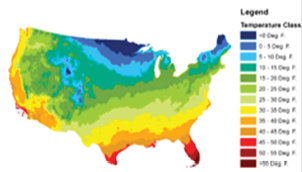
![]() Aridity
Aridity
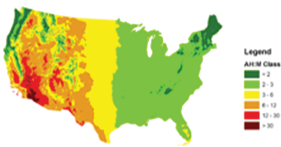
![]() EPA Level III Ecoregions
EPA Level III Ecoregions
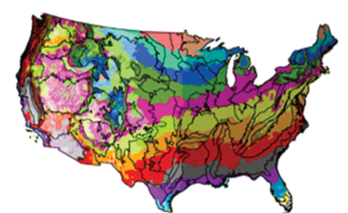
Figure 3-95 | Provisional seed zones
Provisional seed zones for native plants are unique climatically delineated areas (A and B) nested within EPA Level III Ecoregion boundaries (C). The provisional zones can be used to guide seed sourcing decisions when species-specific genetic information is lacking (Bowers and others 2014).
Genetic Variation
Another important issue in selecting native plant materials is maintaining genetic variation in the populations established in revegetation work. This is especially important to ensure resiliency in the context of a rapidly changing climate. Plant populations must be genetically variable to be able to adapt and respond to changing stresses and climates. Collection and propagation procedures, as well as agronomic and nursery production methodologies, need to conserve sufficient genetic diversity to enhance revegetation success and buffer against environmental stresses and changes in both the short and long term (Section 5.3.1 and Section 5.3.4). In addition, a sufficient number of unrelated seed parents must be included to ensure that inbreeding does not become a problem in the future. Both issues come down to numbers—the more plants that contribute to the new population, the more genetic variation will be captured and the lower the likelihood that relatives will mate (less inbreeding). These criteria should be considered by managers, whether they are buying plant materials or collecting their own. When procuring seed on the commercial market, designers should consult with seed producers and distributors and other reputable sources, including government websites and published literature, to determine the most appropriate available plant materials for a project area. Factors to consider include seed source origins relative to the project site, plant development methodologies, and certification class. In many states, the newer native species releases are certified as "Source Identified, Pre-Varietal Releases", which originate from natural stands, seed production areas, seed fields, or orchards where no selection or genetic manipulation of the parent population has been conducted. The Association of Official Seed Certifying Agencies (AOSCA) has published certification standards and guidelines for the certification of Pre-Varietal Germplasm releases, however not all state certifying agencies have adopted these plant release types within their respective state laws and regulations.
Inset 3-7 | Locally adapted plant materials
Choosing the right plant materials for a project is fundamental to revegetation success, both in the short and long term. With inappropriate seed mixes, projects may fail outright (e.g., low germination or high seedling mortality) or lead to more cryptic problems in the future, such as poor regeneration potential, phenological asynchrony with dependent pollinators, genetic degradation of surrounding plant communities, and loss of resiliency and adaptive capacity in responding to new stresses (e.g., invasive plant species or climate change).
A large number of studies have shown that locally derived and genetically diverse plant sources are likely to be best adapted to prevailing climatic and environmental conditions (Hufford and Mazer 2003; Savolainen and others 2007; Johnson and others 2010). This means that in addition to matching species assemblages to a project site, designers must also understand and consider the seed source origin and genetic diversity of available plant materials to be successful (McKay and others 2005; Crémieux and others 2010; Mijnsbruggea and others 2010; Schröder and Prasse 2013). Moreover, federal and state agencies are increasingly suggesting or requiring the use of locally adapted and regionally appropriate native plant materials in revegetation work based on site characteristics and ecological setting (see Appendix 1 in Johnson and others 2010).
Because restoration with native plants is still relatively new in the United States, the supporting research, infrastructure, and plant material development programs are in the early stages of development. Genetic guidelines for determining what is local are often lacking for many native species of interest (Erickson 2008; Johnson and others 2010). As a consequence, native plants of inappropriate or unknown origin are being sold and planted, including some that may originate well outside of the area targeted for planting.
Provisional Seed Zones
Seed zones help identify where plant materials originated and how far they can be moved. Empirical seed zones for individual species are developed through field trials in which a large number of seed sources from a wide range of source environments are evaluated for important adaptive traits, such as growth rate and vegetative and reproductive phenology. By relating measured traits to climate or other environmental variables, researchers are able to create maps and delineate areas (seed zones) that are relatively homogenous with respect to adaptive genetic variation. The seed zones represent areas within which seed and plant materials can be transferred with little risk of maladaptation or other adverse consequences (Campbell 1986; Sorensen 1992; Rehfeldt 1994; Erickson 2004; St. Clair and others 2005).
Generalized or "provisional" seed zones (Bower and others 2014) have been developed for the continental United States using minimum temperature and aridity variables in combination with EPA Level III Ecoregions (Omernik 1987). The resulting map (Figure 3-95) captures much of the variation existing in adaptive seed zones (Bower and others 2014; Kramer and others 2015). Therefore, the combined generalized or "provisional" seed zone and ecoregion mapping approach is a good starting place for species and geographic areas where empirical seed zones are unavailable.
In creating the provisional seed zones, temperature minimum values were grouped into 13 discrete classes that reflect the temperature bands used in the USDA plant hardiness zone map (USDA Agricultural Resource Service 2012). The hardiness map is familiar to designers and land managers and has been widely used for decades. An annual heat:moisture index (AH:M) was used as a measure of aridity to distinguish areas that are warm and wet (low-moderate aridity), cold and wet (low aridity), warm and dry (high aridity), and cold and dry (moderate-high aridity). Index values were divided into six discrete classes, with higher values indicating more arid environments. Intersection of the minimum winter temperature with the AH:M layer created unique climatically delineated (temperature-aridity) zones. In the final map, EPA Level III Ecoregions were overlaid on climate zones to identify areas that differ ecologically although they may be similar climatically (Figure 3-95).
The provisional seed zones, along with empirical seed zones for some native plants, are available online in the Seed Zone Mapper application. Provisional seed zones have also been incorporated into the ERA online tool, discussed in Section 3.3.3, see Ecoregional Revegetation Application (ERA), as an independent map layer.
Failing to consider genetic variation when selecting plant materials could have significant consequences on the viability and sustainability of revegetation efforts. Yet it is easy to imagine how variability can be eroded. If plants are propagated from a very small and inadequate sampling of the population, genetic variation of the propagated plants will be greatly reduced.
Inset 3-8 | What to do if there are no locally adapted native seed sources available
Adapted from Erickson and others 2003; Aubry and others 2005
The volume of seeds needed for a revegetation project may not always be available in sufficient quantities, particularly when plans have changed or the revegetation specialist has not been involved until the latter stages of the project. In these instances, three choices are available to the revegetation specialist:
- wait several years until the appropriate seeds are available;
- use introduced species that are non-persistent, non-invasive, or sterile, or
- use non-native cultivars or non-local native cultivars.
Defer Seeding
If the appropriate species or seed sources are not available, then consider not seeding until the appropriate seeds become available. In the interim, soil cover for erosion control should be considered.
Introduced Species
When appropriate seed sources are unavailable, sterile hybrids or annual/biennial/perennial introduced plant species that are non-persistent and non-invasive may be considered. Preferred non-native species are those that will not aggressively compete with the naturally occurring native plant community, invade plant communities outside the project area, persist in the ecosystem over the long term, or exchange genetic material with local native plant species. Some of these species include sterile hybrids, such as Regreen (a wheat x wheatgrass sterile hybrid) and annuals such as common oat (Avena sativa) and common wheat (Triticum aestivum). Exotic species that have not already been introduced into the area, or that have been found to be aggressive and/or persistent, should be avoided. Non-native species that were commonly used in the past and that should be avoided include Kentucky bluegrass (Poa pratensis), smooth brome (Bromus inermis), crested wheatgrass (Agropyron cristatum), orchardgrass (Dactylis glomerata), yellow and white sweetclover (Melilotus officinalis and M. albus), alsike clover (Trifolium hybridum), and alfalfa (Medicago sativa), among others. These species are generally no longer recommended due to their highly aggressive nature, resulting in widespread displacement of native species and plant communities that are low in diversity and poor pollinator habitat.
Non-Local Native Species
Native species that do not occur naturally in the local ecosystem, or native plant material that does not originate from genetically local sources, may be considered. These types of plant materials may include commercial cultivars. A cultivar is "a distinct, often intentionally bred subset of a species that will behave uniformly and predictably when grown in an environment to which it is adapted" (Aubry and others 2005). These cultivars are generally not preferable for wildland use due to concerns over adaptability, genetic diversity level, and the potential for genetic contamination, or "swamping," of local native gene pools, including those of threatened, endangered, and sensitive plants (Millar and Libby 1989; Knapp and Rice 1994; Linhart 1995; Montalvo and others 1997; Lesica and Allendorf 1999; Hufford and Mazer 2003). Because commercial cultivars are typically selected for agronomic traits, such as high fecundity, vegetative vigor, and competitive ability, their use may also adversely impact resident plant populations through direct competition and displacement. Cultivars bred for traits such as showiness may have little value to pollinators due to low pollen and nectar production. Plant-pollinator relationships could be disrupted if the growth and reproductive cycle of non-locally sourced plants is different or out of sync with pollinator needs (Norcini and others 2001; Houseal and Smith 2000; Gustafson and others 2005). This is especially a concern with specialist pollinators that are reliant on the nectar and pollen from a small subset of plant species and synchronize their annual emergence to the flowering time of their host plants. Cultivars of native species (and introduced look-alikes such as sheep fescue [Festuca ovina]) can also be problematic if they are difficult to distinguish from native germplasm. This could severely complicate efforts to collect and propagate local material and waste valuable economic resources.
Because of these numerous concerns, cultivars should be used sparingly or not at all, with project objectives clearly understood. Consult with the seed producer or distributor before buying seeds and ask for the most appropriate cultivar for the project area, where the source for the cultivar was collected (geographic location and elevation), and how many collections were made. The seeds should be certified with a certification tag attached to each seed bag. Tests for seed germination, purity, noxious weeds, and seeds per pound should be obtained.
Reproductive strategies vary widely among species. No single collection and propagation protocol will ensure the genetic integrity of all types of plants used in revegetation. However, the issue of genetic variation cannot be ignored. The following should be considered when purchasing or collecting native plant materials:
- Number of related individuals—Identifying which plants in a population are likely to be related can be difficult without expensive genetic analyses, but there are ways to minimize the collection of related individuals. In general, avoid collecting plants growing very close to each other to minimize the risk of collecting siblings or even clones of the same plant (Vekemans and Hardy 2004; Rhodes and others 2014). It is recommended to collect plants growing throughout the whole site to ensure that the full diversity of the site is captured, especially plants growing along the edges of each population.
- Number of parents—Collecting seed or cuttings from a minimum of 50 unrelated parent plants will help ensure that most of the genetic variation in a population is captured. Additional plant material would be needed if contribution by parents (of seeds or cuttings) is unequal. For dioecious species, attention to male-female ratios is essential to ensure adequate representation of both sexes.
- Source sites (stands)—To represent the population of a seed zone well, seeds or cuttings should be collected from multiple sites within the zone. A similar number of parents should be sampled from each site. Seek out larger communities to help meet parent selection criteria.
- Individual parents within a selected source—Individual maternal parents (seed plants) should be well separated from each other yet not isolated from other plants of the same species. This will allow cross pollination by numerous paternal parents, adding to diversity. A similar amount of seeds should be collected from each parent. Collecting from plants throughout the entire site will also promote sampling the full range of diversity that is present.
Section 5.3 provides additional guidance on ensuring genetic diversity when collecting seed and cuttings. Guidelines have also been developed to help designers work with seed producers and nurseries that follow practices for maintaining high genetic variability throughout the native plant material production process (e.g., Basey and others 2015).

